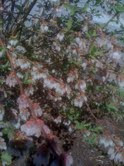Crabapple LandscapExperts are ever-vigilant in their search for insect pests in landscapes under their care. Sometimes if a landscape shrub begins to turn olive in color instead of maintaining a rich leaf-green, the problem can be traced to nearly invisible mites or sap-sucking insects. Piercing mouthparts invade the vascular system of the plants, robbing them of their sap and sometimes indirectly causing harm by introducing plant diseases.
In cases like these, Crabapple LandscapExperts choose the safest and best insect control for the job, and in the cool days of early spring occasionally turn to horticultural oil to stop insect pests. Safety for residents and their pets is our primary concern.
Horticultural oil is a low-toxicity choice especially formulated for use on plants. It can be plant-based or petroleum-based oil with an emulsifier added that allows it to be mixed with water and applied using a regular garden sprayer. It kills scales, mites, aphids, whiteflies and other soft-bodied pests that are present by suffocation, blocking the air holes (spiracles) through which insects breathe, and causing them to die from asphyxiation. Horticultural oils are also effective in controlling plant viruses that are spread by these same piercing and sucking insects.
Horticultural oils pose few risks to people, their pets, or even to beneficial insects (like honey bees or Ladybugs), or to natural enemies of plant-eating pests. Toxicity is minimal, and oils quickly dissipate through evaporation, leaving little residue. Oils also are easy to apply with existing spray equipment and can be mixed with fungicides to control plant diseases if needed.
Crabapple LandscapExperts know that thorough spray coverage is essential when using oils. Since these products are not poisons and are non-toxic to humans and pets, they must contact the insect. All plant surfaces: stems and both tops and bottoms of leaves, are thoroughly coated with spray for best results.
Close-up photo courtesy Wolf Hill Garden Center




















